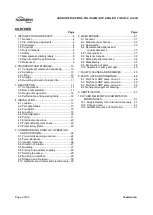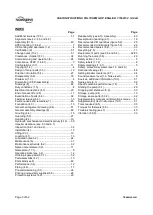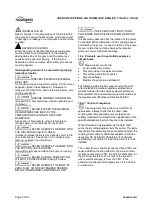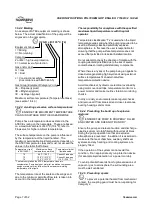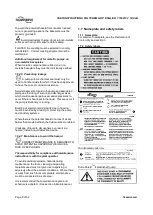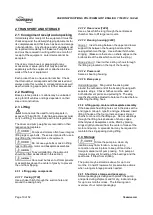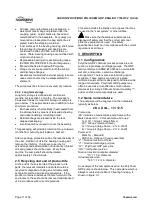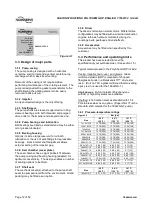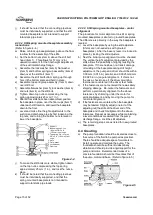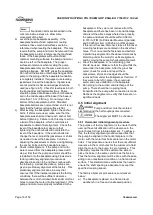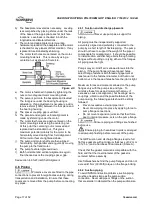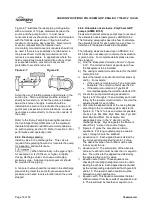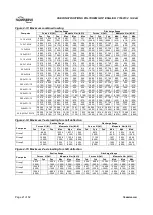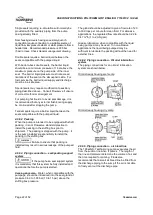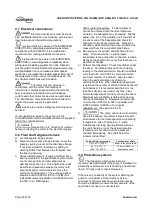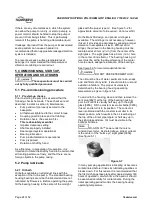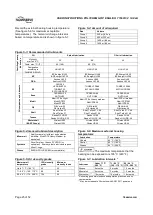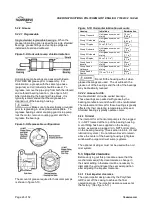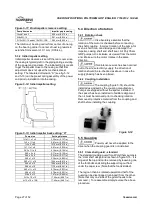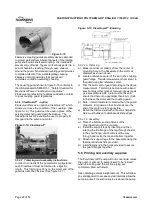
USER INSTRUCTIONS POLYCHEM GRP ENGLISH 71569132 12-04A
Page 13 of 52
flowserve.com
The pressure-temperature charts for PolyChem GRP
pumps are shown in figure 3-2. Maximum fluid
temperature for
Derakane 470™ material
is 121 °C
(250 °F) and for Durcon 730 is 107 °C (225 °F).
The following data are typical, and factors such as
liquid being pumped, temperature, and seal type may
influence them. If required, a definitive statement for
your application can be obtained from Flowserve.
3.4.2 Minimum continuous flow
The minimum continuous flow (MCF) is based on a
percentage of the
best efficiency point
(BEP). Figure
3-3 identifies the MCF for all PolyChem GRP pump
models.
Figure 3-3
MCF (% of BEP)
Size
3 600
r/min
3 000
r/min
1 800
r/min
1 200
r/min
1J1.5x1G-6
10
10
10
10
1J3x1.5G-6
10
10
10
10
1J3x2G-6
10
10
10
10
1J3x2GS-7
10
10
10
10
1J1.5x1G-8
10
10
10
10
2K3x1.5G-8
10
10
10
10
2K3x2G-8
10
10
10
10
2K4x3G-8
20
20
20
20
2K2x1G-10
10
10
10
10
2K3x1.5G-10
N/A
10
10
10
2K4x3G-10
N/A
25
25
25
2K6x4G-10
N/A
25
25
25
2K3x1.5G-13
N/A
N/A
25
25
2K4x3G-13
N/A
N/A
25
25
3J8x6G-13
N/A
N/A
25
25
3J12x10G-15
N/A
N/A
N/A
25
4J12x10G-15B
N/A
N/A
25
25
3.4.3 Minimum suction pipe submergence
The minimum submergence is shown in figure 3-4 and
3-5 for the 1K3x2GS-7 unitized self-priming pump.
Figure 3-4: Minimum submergence
Figure 3-5: Minimum submergence
3.4.4 Suction pressure limits
Open style impellers typically create a thrust load
towards the suction of the pump. This reduces the axial
loading on the bearings so that the suction pressure
limit is equal to the pressure-temperature rating.
4 INSTALLATION
Equipment operated in hazardous locations
must comply with the relevant explosion protection
regulations. See section 1.6.4,
Products used in
potentially explosive atmospheres.
4.1 Location
The pump should be located to allow room for access,
ventilation, maintenance and inspection with ample
headroom for lifting and should be as close as
practicable to the supply of liquid to be pumped. Refer
to the general arrangement drawing for the pump set.
4.2 Part assemblies
The supply of motors and baseplates is optional. As
a result, it is the responsibility of the installer to
ensure that the motor is assembled to the pump and
aligned as detailed in sections 4.5 and 4.8.
4.3 Foundation
4.3.1 Protection of openings and threads
When the pump is shipped, all threads and all
openings are covered. This protection/covering
should not be removed until installation. If, for any
reason, the pump is removed from service, this
protection should be reinstalled.
4.3.2 Rigid baseplates - overview
The function of a baseplate is to provide a rigid
foundation under a pump and its driver that maintains
alignment between the two. Baseplates may be
generally classified into two types:
Foundation-mounted, grouted design (figure 4-1)
Stilt mounted, or free-standing (figure 4-2)


